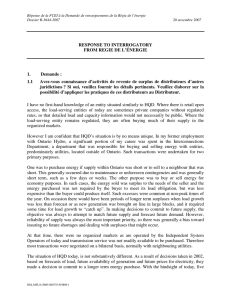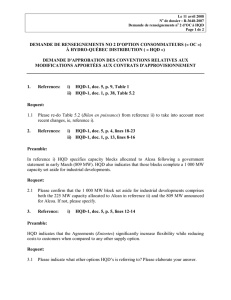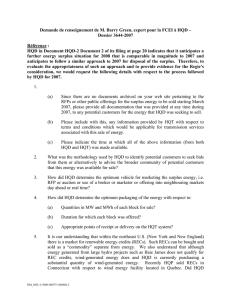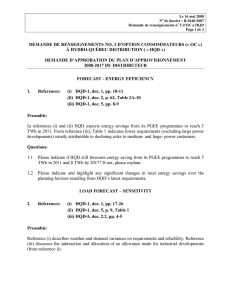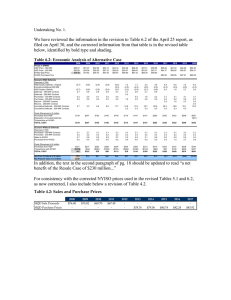RÉGIE DE L'ÉNERGIE HYDRO QUÉBEC DISTRIBUTION DOSSIER R-3541-2004
advertisement
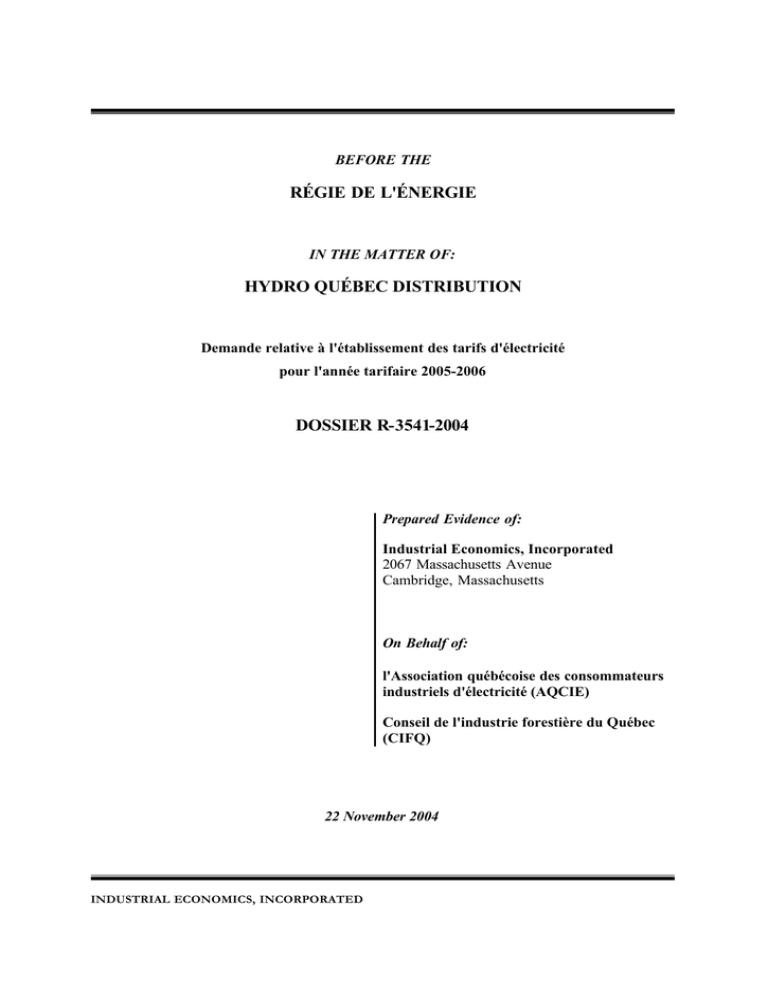
BEFORE THE RÉGIE DE L'ÉNERGIE IN THE MATTER OF: HYDRO QUÉBEC DISTRIBUTION Demande relative à l'établissement des tarifs d'électricité pour l'année tarifaire 2005-2006 DOSSIER R-3541-2004 Prepared Evidence of: Industrial Economics, Incorporated 2067 Massachusetts Avenue Cambridge, Massachusetts On Behalf of: l'Association québécoise des consommateurs industriels d'électricité (AQCIE) Conseil de l'industrie forestière du Québec (CIFQ) 22 November 2004 INDUSTRIAL ECONOMICS, INCORPORATED R-3541-2004 1. Introduction and Summary of Conclusions Industrial Economics, Incorporated (IEc) was retained by l'Association québécoise des consommateurs industriels d'électricité (AQCIE) and the Conseil de l'industrie forestière du Québec (CIFQ) to review the filing of Hydro Québec Distribution (HQD) regarding its proposals for the allocation of post-patrimonial energy costs, and for establishing a deferral account for all net generation cost variances. In particular, IEc was asked to evaluate the possibility of allocating post-patrimonial energy costs and variances on an incremental rather than rolled-in basis. Based on our review, IEc concludes: • Incremental allocation methods for post -patrimonial energy costs are not consistent with cost causation, with basic principles of fairness, or with significant regulatory precedents, and would likely result in complex and contentious allocation analyses. HQD's proposal to allocate generation costs on a rolled-in basis should be approved. • While the current method for allocating patrimonial energy is not fully consistent with economic cost causation, it has been specified by the legislature and approved by the Régie. In that context, it is reasonable to apply the same methodology to postpatrimonial energy costs. • HQD's proposal to adopt a deferral account for net generation cost variances will reduce its incentives to minimize costs and will impose significant risk on ratepayers. However, we recommend that the proposal be approved on a tentative basis, with the proviso that the deferral account be subject to a thorough prudence review at the time it is rolled into rates. This evidence has been prepared by and under the direction of Mr. Robert D. Knecht of IEc. Mr. Knecht's curriculum vitae and a schedule of his expert testimony in regulatory proceedings are attached to this evidence as Exhibit IEc -1. INDUSTRIAL ECONOMICS, INCORPORATED R-3541-2004 2. Allocation of Post-Patrimonial Energy Costs a. Rolled-In Versus Incremental Cost Allocation Methodologies With the forecast increase of domestic electricity demand above that provided for in the heritage pool, HQD faces the issue of how to allocate generation costs. Heritage pool generation costs are allocated pursuant to a methodology that is implicitly specified in the legislation, and which has been approved by the Régie. 1 The average generation rates for heritage pool energy are substantially below the current market prices for generation. HQD estimates the current retail market prices for power at $80.6 per MWh, compared to the legislated average rate for heritage pool energy of $27.7 per MWh. Thus, the growth in domestic load will cause HQD to incur incremental generating costs that far exceed average generating costs. This economic situation has numerous precedents in regulatory economics. For example, in the 1970s and 1980s, new generating plants (particularly nuclear plants) provided power at substantially higher cost than existing generation plants. More recently, expansions of the electricity or gas transmission grids are more costly than existing assets per unit of demand, and cause average costs to increase. Under these circumstances, the temptation, particularly for parties who represent existing customers, is to advocate the use of incremental cost allocation approaches. In an incremental approach, the high costs of the new power supplies are somehow allocated only to the new customers or to growing loads. The alternative methodology is to allocate all of the generating costs to all loads, regardless of their status as "old" or "new." This latter approach can be described as rolled-in cost allocation. In our review of the relative attractiveness of these options for HQD, IEc considered the issues of cost causation, fairness, stability, simplicity, and regulatory precedent. 2 The object of this exercise is, in essence, to determine how the enormous benefit of the low-cost heritage pool should be shared among ratepayers. 3 1 Régie de l'Énergie, Décision D-2002-221, R-3477-2001, 21 October 2002. 2 This list comprises the relevant characteristics of a sound rate structure, as outlined by Bonbright, et al. See, Principles of Public Utility Rates, Second Edition, Bonbright, Danielsen, Kamerschen, 1988, at 383-384. 3 At a discount to market of $53 per MWh ($80.6 per MWh less $27.67 per MWh) and a heritage pool of 166.4 TWh per year, the value of the heritage pool is over $8,800 million per year. See HQD-12, Document 1 for adjustments to heritage pool volumes and costs associated with reduction in loss factor. INDUSTRIAL ECONOMICS, INCORPORATED 2 R-3541-2004 b. Cost Causation Cost causation is generally regarded as the most important criteria for selecting a cost allocation methodology. As NARUC indicates: "Cost analysts must devise methods to equitably allocate these costs among all customer classes such that the share of cost responsibility borne by each class approximates the costs imposed on the utility by that class."4 While it may be tempting to blame new customers for energy demand tha t exceeds the limits of the heritage pool, it is simply wrong to conclude that "new load" is any more causally responsible than "old load" for increased demand. Each customer that decides to turn up the electric heater, to put on the store lights, or to smelt an additional ton of aluminum contributes to the overall demand. An increase in load associated with a new residential subdivision is no more responsible for post-patrimonial energy than is the load from an established paper mill. The incremental costs associated with the post-patrimonial energy could be avoided by either (a) the new subdivision not being built, or (b) energy efficiency measures being implemented by the paper mill. In short, all customers contribute to the need for post-patrimonial energy. As Professor Kahn explains in his seminal text on regulatory economics: "Suppose, for example, the utility has two groups of customers, one, A, whose demand is stable, another, B whose demand is increasing. And suppose expansion of the latter de mand finally requires expansion of capacity. Does that mean, following our rules of peak responsibility pricing, that B are the marginal buyers on whom capacity costs alone should be imposed? Obviously not. True, it is the increase in B's purchases that precipitates the additional investment; but the additional costs could just as well be saved if A reduced their purchases as if B refrained from increasing theirs. So A's continuing to take service is just as responsible, in proportion to the amount they take, for the need to expand investment as B's increasing needs, and A should therefore be forced just as much as B to weigh the marginal benefits of the capacity to them against the marginal costs they impose on society by continuing to make demands. This reasoning clearly applies even when incremental investment costs per unit of capacity are rising and where, again, it might appear on first consideration that since it is the expansion of the B demands that it is responsible for the supplier's incurring the higher costs, it is that group that ought to bear the additional burden. Even though B's demand is 'marginal' in the temporal sense, both groups are marginal 4 "Electric Utility Cost Allocation Manual," National Association of Regulatory Utility Commissioners, January 1992, page 33. INDUSTRIAL ECONOMICS, INCORPORATED 3 R-3541-2004 in the economic sense. Both should be forced to match those higher capacity costs against the satisfaction they derive from continuing to use the service. 5 Therefore, the cost causation principle dictates that a rolled-in cost allocation method should be adopted in the circumstances facing HQD. 6 c. Fairness As noted above, the key implication of the generation cost allocation methodology chosen is how the economic benefits of the heritage pool are shared between customer classes and between customers themselves. The implication of incremental methods of cost allocation is that existing customers are entitled to low-cost heritage pool power for all of their current loads, presumably in perpetuity, and that new loads have no such entitlement. The implication of the rolled-in method is that all customers, new and old, have an equal entitlement to the low-cost energy. Which approach is more fair? Professor Bonbright defines fairness as avoiding "arbitrariness and capriciousness" and to ensure that "equals are treated equally" and "unequals are treated unequally." 7 In evaluating the fairness of the methods, it is important to recognize that if energy costs are allocated to rate classes using incremental methods, it is only reasonable to pass those costs on to individual customers using the same methodology. Thus, for example, for the Rate L class, if post-patrimonial energy costs are assigned to incremental load, it is only reasonable to pass all those costs onto the industrial customers who are just starting up new facilities or who have expanded their existing facilities. From that perspective, incremental cost allocation methods fail the fairness test. It is hard to contemplate how existing customers would be more deserving of the benefits of the patrimonial energy pool than new customers are. Both existing and new customers live and work in Québec, and both sets of customers contribute to the vitality of the economy. Moreover, 5 The Economics of Regulation, Principles and Institutions, Kahn, Alfred E., 1988, page 140. 6 Note that incremental pricing has its place in utility ratemaking. Consider the idea of customer contributions. When the tariff rates from a new customer are not sufficient to justify the expansion cost needed to serve that customer, utilities may impose a charge on the new customers to protect existing customers. Note, however, the key cost causation differences between the customer contribution example and the heritage pool example. For customer contributions, the new customer is the only user of the new facilities and is therefore causally responsible for it; in the Québec heritage pool case, all customers are using the resource and therefore all customers contribute to causation. 7 Principles of Public Utility Rates, Second Edition, Bonbright, Danielsen, Kamerschen, 1988, at 383-384. INDUSTRIAL ECONOMICS, INCORPORATED 4 R-3541-2004 incremental cost methods must necessarily result in equals being treated unequally. Consider some of the fairness implications of incremental methods: • New residential subdivisions would face higher rates than existing customers; in effect, equals are treated unequally; • A residential customer who moves from a "grandfathered" residence to a new home may face a large increase in electric rates (unless HQD establishes complex systems for tracking individuals' eligibility); • HQD would charge different rates to businesses that compete with each other, thereby implicitly providing a competitive advantage to existing businesses; • By providing competitive advantages to existing businesses, HQD would implicitly discourage the replacement of older, less efficient firms by newer more efficient firms.8 Thus, not only do incremental methods fail the fairness test, they can create inefficient competitive advantages and disadvantages between business customers. d. Stability and Simplicity The criteria for sound utility rates usually emphasize the advantages that rates are reasonably stable over time, and that they are simple to develop and understand. Consider, however, the implications of incremental cost methodologies. First, HQD would need to determine exactly which customers are entitled to the low cost energy. Immediately questions arise. • What historical period should be used for this entitlement? • Should it be a warm winter, cold winter or average winter? • Should it recognize extraordinary plant shutdowns or strikes? • Should it be an economic up-cycle or down-cycle? 8 Granting saleable entitlements to existing customers can potentially mitigate this problem. However, such an entitlement scheme would still inequitably benefit existing customers, and would require complex administrative procedures. INDUSTRIAL ECONOMICS, INCORPORATED 5 R-3541-2004 Even assuming that is possible to make such an allocation of entitlements, how would HQD then address a situation in which residential demand is extraordinarily high due to cold weather, but industrial demand is relatively low due to plant shutdowns? Should the excess residential demand be assigned higher rates, even if HQD does not incur post-patrimonial energy costs? Or, to make the problem even more complex, suppose that HQD decides to maximize its use of patrimonial energy during peak winter and summer periods when prices are high, and implicitly buy post-patrimonial energy in off-peak hours and seasons.9 Should these off-peak purchases of post-patrimonial energy apply only to users during those off-peak periods? As HQD indicates, any effort to try to match the incremental loads with the post-patrimonial supply would be extraordinarily complex. 10 Turning to the stability criterion, incremental cost allocation has the advantage of preserving price stability for existing loads, at the expense of wildly unstable prices for new loads. As HQD details, its incremental costs per kWh of post-patrimonial load will vary significantly, depending on which resources are being used at any particular time, the fixed nature of the costs under some contracts, and the overall volume of post-patrimonial energy. Under these circumstances, it would be virtually impossible for a new customer to have any reasonable expectation of what his rates will look like more than one year out. This uncertainty and instability in rates will assuredly discourage investment in the province, in all sectors of the economy. In short, incremental cost allocation methods will likely result in rates that are complex and unstable. e. Regulatory Precedent IEc generally does not advocate the use of precedent as a key factor in making cost allocation recommendations, as the precedent can often be found to support both sides of an issue. Nevertheless, the use of a rolled-in cost allocation methodology in circumstances similar to those faced by HQD is well established. First, consider the example of the traditional regulation of generation. During the 1970s and 1980s, the capacity costs for new plants implied that new generating costs (particularly for nuclear power plants) were substantially higher than those of the existing power plants. In general, regulators rolled in the costs of the new facilities and recovered the m in rates to all customers, and did not attempt to assign the high cost facilities only to new loads. 9 HQD indicates that it has some flexibility for following such a strategy. See, for example, HQD-14, Document 5.1, item 1(e). 10 See HQD 14, Document 1, item 31. INDUSTRIAL ECONOMICS, INCORPORATED 6 R-3541-2004 Second, the NEB took on this issue in a key case relating to the expansion of TransCanada Pipeline (TCPL) capacity. Specifically, some of TCPL's domestic customers were advocating that they retain entitlements to existing lower-cost capacity, and that the higher incremental costs be assigned only to new load (much of which was export load). The NEB indicated: "The Board has decided that all facilities in the GH-5-89 proceedings, whether approved under section 52 or exempted under section 58 of the Act, will be rolled into TransCanada’s rate base for toll purposes. With respect to future expansions, the Board did not make its finding respecting rolled-in methodology to be generic, but it expects that there would have to be a clear demonstration of radically changed circumstances before the issue of tolling methodology would warrant reexamination." . . . "In this regard, the Board agrees with those who submitted that the payment of tolls confers no future benefit on tollpayers beyond the provision of service. In other words, previous tollpayers have no acquired rights. Therefore, they cannot expect to be exempted from a toll increase simply because they have paid tolls in the past." . . . "With regard to the debate as to who caused the need for the new facilities, the Board is persuaded by the argument that it is the aggregate demand of all shippers that gives rise to the need for additional pipeline capacity."11 Third, the deregulation of electricity generation in some jurisdictions, combined with the regionalization of transmission operation, have given rise to rolled-in versus incremental costing issues. In particular, regulators face the question as to whether rolled-in or incremental methodologies should be used for assigning the benefits of, or rights to, existing lower -cost transmission assets. The Alberta Energy & Utilities Board, after an extensive review of this issue, determined that a rolled-in approach was superior: "The Board considers that it would be fair to charge the locational price to both new and existing customers, since both new and existing generators contribute to the congestion on congested transmission paths. The Board considers that both generators who decide to enter the market and generators who decide not to exit the market benefit from the transmission upgrade, and therefore both new and old generators should bear the supply portion of the upgrade costs."12 11 National Energy Board, Reasons for Decision, In the Matter of TransCanada PipeLines Limited, GH-589, November 1990, Volume 1 Tolling and Economic Feasibility. 12 Alberta Energy and Utilities Board, Decision 2002-099: Transmission Administrator; Congestion Management Principles, Application No. 1248859, page 84. INDUSTRIAL ECONOMICS, INCORPORATED 7 R-3541-2004 f. The HQD Generation Cost Allocation Methodology Having determined that a rolled-in methodology is the economically preferable option, we turn to the cost allocation methodology. HQD proposes to apply and extend the methodology that was approved by the Régie in R-3477-2001 for heritage pool energy costs. IEc prepared a report analyzing that methodology, which was subsequently filed as evidence in that proceeding. As detailed in that report, HQD's methodology is mathematically equivalent to a cost allocation process that consists of: • Classifying total costs into energy and demand components, based on the systemwide load factor; • Allocating energy-related costs on the basis of loss-adjusted energy consumption; • Allocating demand-related costs on the basis of loss-adjusted peak demands, where peak demand consists of the top 300 hourly peaks during the course of the year. As detailed in IEc's report in R-3477-2001, HQD's methodology is not fully consistent with cost causation principles, and it tends to allocate more costs to indus trial rate classes than methods traditionally used by other Canadian electric utilities. For example, the load factor classification split assigns a relatively high share of generation costs to energy, compared to the historical practices of regulated Canadian utilities. Also, HQD's use of a 300-hour peak further increases the cost responsibility of large industrial customers, despite the fact that generating capacity must be retained that is sufficient to meet a single peak. In addition, the load-factor classification scheme penalizes the industrial classes for improvement in system load factor, despite the fact that improved system load factor should reduce costs for all rate classes. In that proceeding, the Régie determined that the allocation methodology used by HQD was, for legal reasons, required by the Act. The Régie therefore approved that approach without addressing the economic or equity issues in detail. Thus, it is IEc's understanding at this stage that the HQD methodology must be applied to heritage pool costs for legal reasons. Because IEc recommends a rolled-in approach to generation cost allocation, HQD's proposal to expand the application of this methodology to all generation costs is not unreasonable. However, if the issue of overall allocation of generation costs is legally "on the table" in these proceedings, IEc respectfully reiterates support for the economic modifications to the HQD methodology that we made in the R-3477-2001 proceedings. INDUSTRIAL ECONOMICS, INCORPORATED 8 R-3541-2004 3. Deferral Account for Generation Costs In its filing, HQD proposes to establish a deferral account for all net generation costs. That is, HQD will defer any difference between actual generation costs and the forecast generation costs, net of any difference in revenues. In effect, the HQD proposal will include both price and volume variances. HQD further proposes that the net variance be added to the forecast generation cost pool, and allocated to the rate classes using the generation cost allocation methodology. HQD's primary reasons for adopting a complete deferral account are that it has no control over the variation in volume, and that the difference between the incremental revenues and incremental generation costs are significant. HQD is particularly concerned because its incremental revenues are likely to be based on average generation costs, most of which are determined by the heritage pool costs, while its incremental costs are likely to be the higher postpatrimonial costs. As a general rule, regulators try to avoid using deferral accounts except in specific circumstances. The primary disadvantage of a deferral account is that it eliminates the incentives for the utility to attempt to minimize costs. If the utility is assured that it will recover the costs through the deferral account, it has little incentive to try to keep costs under control. In the case of HQD, such cost controls could include aggressive procurement efforts with generation suppliers, aggressive management of suppliers to insure that they meet their contractual obligations, and optimal use of the low-cost heritage pool resource. HQD's proposal eliminates any incentives that it might otherwise have to keep total generating costs down. An additional disadvantage to deferral accounts is that they shift weather, volume and poor management risks from the utility to the ratepayer. In the case of HQD, this reduction in risk cannot be matched by any corresponding reduction in rates of return, since there are no generation assets on which HQD earns a return. 13 Thus, under HQD's proposal, the risk of weather variations, macroeconomic cycles and plant shutdowns will be borne by ratepayers rather than the utility. In effect, industrial customers will bear risks associated with climatic changes that affect residential and commercial demands, and residential customers will bear the risks associated with industrial plant closures and strikes. Of course, imposing these risks on business customers makes business planning that much more difficult, and it reduces the economic attractiveness of Québec as an investment option. 13 Note that even in the unlikely event that such a risk shift is explicitly reflected in HQD's rate of return, large industrial customers will benefit only slightly, because industrial customers do not use the distribution assets that comprise most of HQD's rate base. Thus, industrial customers would assume significant risks in exchange for little benefit. INDUSTRIAL ECONOMICS, INCORPORATED 9 R-3541-2004 For those reasons, regulators generally use deferral accounts only for those costs that are out of the control of the utility, and for which the utility faces significant risks. In HQD's case, much of the volume variation is beyond its control, and HQD does face significant financial risk associated with the volume variation. Nevertheless, HQD does have significant control over the costs of post-patrimonial energy. Finally, note that one disadvantage of rejecting HQD's proposal for a deferral account is that it will create an incentive for HQD to over-forecast costs. For example, having no deferral account for HQD could give it the incentive to present relatively optimistic forecasts for energy sales to the Régie, which would increase its net generation costs by overstating the postpatrimonial high-cost energy. Unless the Régie and the intervenors have unfettered access to all HQD's load forecasting analyses and its post-patrimonial energy contracts, it will be difficult to insure that the forecast is fair and equitable. In light of these consideration, and recognizing that this is the first year in which significant post-patrimonial energy costs will be incurred, IEc recommends that the Régie approve the proposed deferral account for the current proceeding. However, IEc suggests that the Régie require that HQD provide a full analysis of that variance at the time the deferral amount is passed on to ratepayers, and that HQD's efforts to control costs are subject to a prudence review at that time. Evidence Prepared By and Under the Direction of: ________________________________________ Robert D. Knecht INDUSTRIAL ECONOMICS, INCORPORATED _____________________ Date 10 R-3541-2004 EXHIBIT IEc-1 CURRICULUM VITAE AND EXPERT TESTIMONY SCHEDULE ROBERT D. KNECHT INDUSTRIAL ECONOMICS, INCORPORATED
